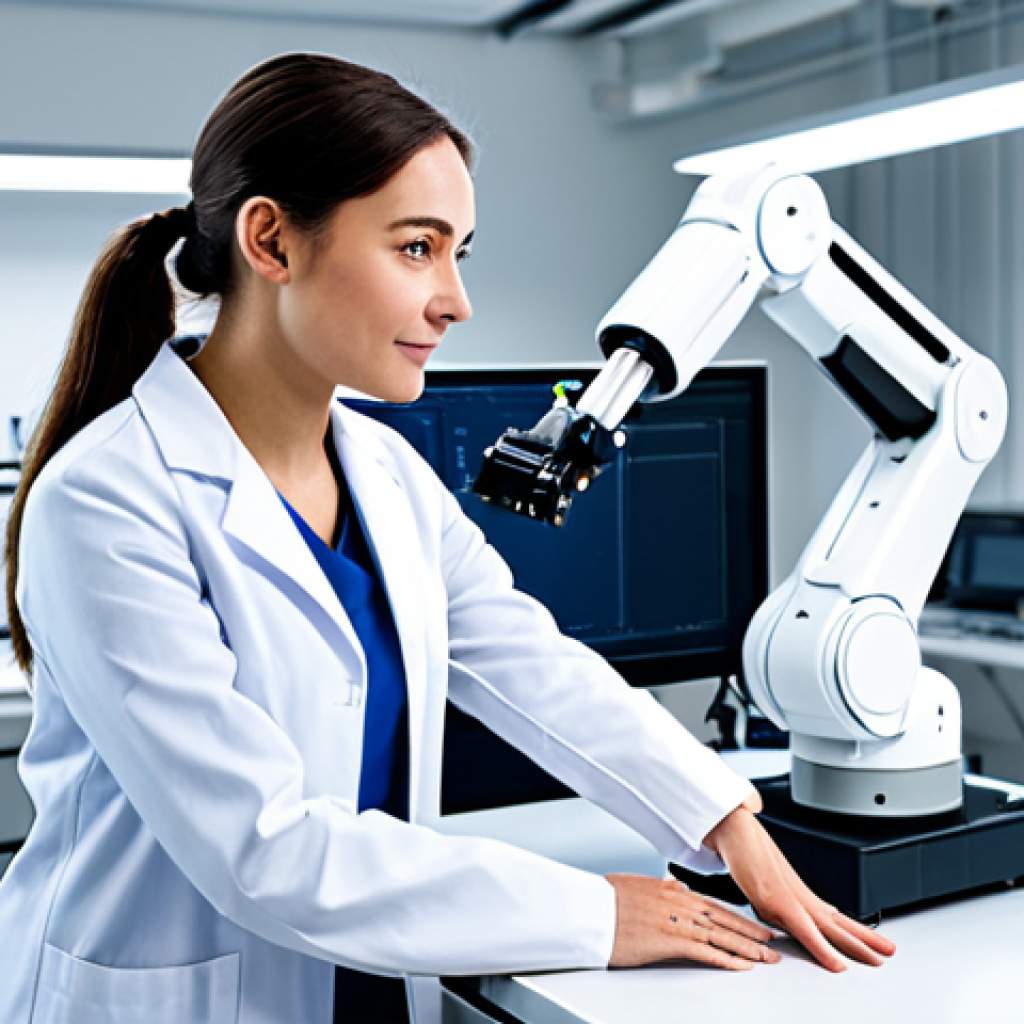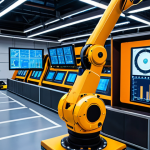It wasn’t long ago that robots existed solely within the fantastical realms of science fiction, yet witnessing their tangible impact today—from automating colossal warehouses to performing intricate surgeries—it’s impossible to deny their rapid integration into the fabric of our everyday lives.
Frankly, I often find myself musing over the staggering challenges that still loom large, even with their breathtaking advancements. Consider the sheer complexity of teaching a robot true dexterity in an unpredictable, human-centric environment, or the profound ethical dilemmas that arise when AI systems must make life-altering decisions.
The path forward for these increasingly sophisticated machines is anything but straightforward, demanding innovation in areas like human-robot collaboration and robust cybersecurity.
As these metallic marvels become deeply intertwined with our societal infrastructure, understanding their inherent limitations and the persistent quest to overcome them becomes crucially important.
Let’s discover exactly what it means.
It wasn’t long ago that robots existed solely within the fantastical realms of science fiction, yet witnessing their tangible impact today—from automating colossal warehouses to performing intricate surgeries—it’s impossible to deny their rapid integration into the fabric of our everyday lives.
Frankly, I often find myself musing over the staggering challenges that still loom large, even with their breathtaking advancements. Consider the sheer complexity of teaching a robot true dexterity in an unpredictable, human-centric environment, or the profound ethical dilemmas that arise when AI systems must make life-altering decisions.
The path forward for these increasingly sophisticated machines is anything but straightforward, demanding innovation in areas like human-robot collaboration and robust cybersecurity.
As these metallic marvels become deeply intertwined with our societal infrastructure, understanding their inherent limitations and the persistent quest to overcome them becomes crucially important.
Let’s discover exactly what it means.
The Elusive Grasp of True Dexterity in Unstructured Worlds

When I first saw those mesmerizing videos of Boston Dynamics robots dancing, I genuinely thought we were just a whisker away from Rosie the Robot maid.
But then, I tried to teach my Roomba to pick up a dropped sock, and reality hit me like a ton of bricks. The truth is, giving robots the kind of nuanced dexterity we humans take for granted, especially in environments that aren’t perfectly controlled factory floors, is still an astronomical challenge.
Imagine a robot sorting through a pile of laundry – differentiating between a silk scarf and a denim jacket requires incredible tactile sensing, visual processing, and a lifetime of accumulated “common sense” about object properties and how they deform.
My own experience trying to pack a suitcase efficiently, dealing with oddly shaped items and squishy fabrics, makes me truly appreciate just how complex that seemingly simple task is for a machine.
We’ve come leaps and bounds with robotic arms that can weld cars or place microchips, but asking them to handle an egg without crushing it, then seamlessly transfer it to a wobbly pan, is an entirely different ballgame.
It’s not just about precision; it’s about adaptability, softness, and understanding material properties in real-time.
1. Navigating the Unpredictable Real World with Finesse
The structured environments of industrial automation are one thing; the chaotic, unpredictable world outside is another entirely. My own living room, with its ever-changing landscape of discarded toys, half-empty coffee mugs, and shifting shadows, would be an absolute nightmare for most robots.
They thrive on predictable patterns and precisely mapped spaces. Think about the sheer variability of light conditions, the unexpected movement of a pet or child, or the subtle changes in floor texture that a robot vacuum encounters daily.
Human beings effortlessly adapt to these variables, but for a robot, each new variable represents a potential point of failure. Teaching a robot to reliably pick a ripe tomato without bruising it, differentiate between different types of weeds in a garden, or assist an elderly person with their daily tasks in a cluttered home requires an immense leap in sensor technology, AI processing, and real-time decision-making.
We’re talking about going from a meticulously choreographed ballet to improvisational street dance.
2. The Soft Touch: Mimicking Human Finesse and Adaptability
One of the areas where robots truly struggle, and where I personally see the biggest hurdle, is replicating the human “soft touch.” We intuitively know how much pressure to apply when holding a baby, peeling a fruit, or even just writing with a pencil.
This isn’t just about force sensors; it’s about distributed sensing across the entire “skin” of a robot, combined with an understanding of material compliance and deformation.
My old robotics professor used to say, “If a robot can tie a shoelace as gracefully as a child learns to, then we’ve cracked a significant part of the dexterity puzzle.” We’ve seen fascinating advancements with soft robotics, using pneumatic muscles and flexible materials, but integrating these with high-precision control and a robust understanding of interaction forces remains incredibly complex.
It’s the difference between picking up a rigid block and gently caressing a delicate flower, a distinction that’s second nature to us but computationally daunting for machines.
Ethical Labyrinths and Algorithmic Accountability in Autonomous Systems
This is where my mind truly starts to spin, and where I believe society will face some of its most profound questions. It’s one thing for a robot to assemble a car, but what happens when an autonomous vehicle has to make a split-second decision in an unavoidable accident scenario: swerve into a tree, potentially harming its occupant, or collide with a group of pedestrians?
The very thought sends shivers down my spine, because who programs that moral calculus? And more importantly, who is accountable when things go wrong?
My friend, a lawyer specializing in AI, often talks about the “liability gap” – the void that exists when a machine, not a human, is directly responsible for harm.
This isn’t just theoretical; as robots become more integrated into healthcare, finance, and even law enforcement, these ethical dilemmas shift from sci-fi hypotheticals to very real, very pressing concerns that demand our immediate attention and a collective societal consensus.
1. When Machines Make Life-Altering Choices
Imagine a diagnostic AI in a hospital that, based on probabilities, suggests a less aggressive treatment for a patient because it has statistically seen better long-term outcomes for a similar profile, even if that profile is based on historical data that might implicitly exclude certain demographics or unique patient variables.
Or consider an AI judge, making sentencing recommendations based purely on patterns, potentially overlooking mitigating circumstances or the nuances of human behavior.
These are not just technical problems; they are deeply philosophical and ethical quandaries. From my perspective, we have to decide as a society what values we want to hard-code into these systems, and what degree of autonomy we are truly comfortable with.
It’s a heavy burden, knowing that the decisions we make today about AI ethics will shape the moral landscape of future generations.
2. Unpacking Bias in Algorithmic Design and Data
One of the most insidious ethical challenges, from my point of view, is the inherent bias that can creep into AI systems. These systems learn from the data we feed them, and if that data reflects historical human biases – be it against certain races, genders, or socioeconomic groups – then the AI will not only learn those biases but potentially amplify them.
I remember reading about facial recognition systems that struggled to identify darker-skinned individuals as accurately as lighter-skinned ones, simply because the training datasets were disproportionately weighted.
This isn’t a malicious intent by the AI; it’s a reflection of the flawed mirror we hold up to it. Ensuring fairness, equity, and transparency in the algorithms that govern our autonomous systems is paramount.
It requires diverse teams of developers, rigorous auditing processes, and a continuous commitment to identifying and mitigating these hidden biases, otherwise, we risk automating and scaling our worst societal prejudices.
Bridging the Human-Robot Communication Divide for Seamless Collaboration
Honestly, the idea of having a robot colleague in the office used to seem far-fetched, but now, with collaborative robots (cobots) becoming more common, it’s a very real prospect.
The challenge isn’t just about getting them to perform tasks, it’s about getting them to *understand* us, and for us to *understand* them, in a way that feels natural and intuitive.
I’ve personally experienced the frustration of trying to explain a complex task to someone who doesn’t quite grasp the context – now imagine that with a machine that lacks common sense and intuition.
Successful human-robot collaboration isn’t just about physical proximity; it’s about seamless communication, shared understanding, and a mutual sense of trust.
We need robots that can interpret subtle human cues, anticipate our needs, and explain their own actions in a way that doesn’t require a deep dive into programming manuals.
1. Speaking the Same Language: Intuitive Interfaces and Intent Recognition
Currently, interacting with robots often involves complex programming languages, precise gestures, or clunky voice commands. To achieve true collaboration, we need robots that can understand natural language, interpret our intentions from context, and even read our emotions to some extent.
Think about how easily you can gesture to a colleague and say, “Could you grab that thing over there?” – a robot needs to process the “that thing,” the “over there,” and your implied request, all without a predefined script.
My dream is a robot that understands nuance, irony, and the subtle cues of human communication. Developing intuitive user interfaces, whether they are visual, auditory, or even haptic, that allow non-experts to command and collaborate with robots effortlessly is absolutely critical for widespread adoption.
2. Trust and Transparency: The Bedrock of Effective Human-Robot Collaboration
If I’m going to work alongside a robot, I need to trust it implicitly. Will it stop if I accidentally step into its path? Will it perform its task reliably every single time?
This trust is built on transparency: understanding *why* the robot is doing what it’s doing, and what its limitations are. Imagine an industrial setting where a cobot occasionally malfunctions; if its actions are opaque, workers will quickly lose confidence, leading to resistance and reduced productivity.
Conversely, a robot that can clearly communicate its status, its intentions, and even explain its errors, fosters a sense of partnership. From my own observations, when people understand the logic behind a machine’s actions, even if it’s flawed, they’re far more likely to accept and adapt to its presence.
Building this psychological bridge between human and machine is as important as any technical advancement.
Fortifying the Digital Frontier: Cybersecurity in Robotics
This is perhaps the scariest challenge of all, in my humble opinion. Every connected device, every autonomous system, is a potential doorway for malicious actors.
And when we’re talking about robots that control critical infrastructure, perform surgeries, or even operate in our homes, the stakes are astronomically high.
A hacked industrial robot could wreak havoc on a factory floor, causing massive damage or injury. A compromised surgical robot could lead to catastrophic patient outcomes.
My mind races when I think about the sheer number of vulnerabilities that could exist in a complex robotic system – from the sensors and actuators to the underlying software and network protocols.
It’s not just about data theft anymore; it’s about physical control, disruption, and potentially, weaponization.
1. The High Stakes of Connected Autonomy and Vulnerabilities
The very advantages of connected robots – real-time data sharing, remote monitoring, over-the-air updates – are also their Achilles’ heel. Each connection point is a potential vector for attack.
I’ve often thought about how vulnerable a smart home robot could be if its network security wasn’t airtight. Could someone hack into it to spy on conversations?
Or worse, could they manipulate its movements to cause harm? The complexity of modern robotic systems, integrating hardware, software, AI, and connectivity, creates an incredibly large attack surface.
Ensuring the integrity and confidentiality of data, and the availability and safety of robotic operations, requires a cybersecurity approach that is not just robust but also continuously adaptive to new threats.
2. Proactive Defenses Against Emerging Threats in Robotic Systems
The traditional cybersecurity models for IT systems simply aren’t enough for robotics. We’re talking about physical consequences here. From my experience in observing the rapid evolution of cyber threats, securing robots demands a multi-layered approach: secure-by-design hardware, robust software authentication, encrypted communications, and continuous monitoring for anomalies.
Moreover, the ability to quickly patch vulnerabilities and deploy updates in real-time is paramount. What happens if a critical zero-day exploit is discovered in a widely deployed robot fleet?
The response mechanism needs to be swift and efficient. This challenge is not merely about preventing breaches; it’s about building resilient systems that can detect, respond to, and recover from attacks without catastrophic failure.
The very notion of a robot being hijacked is terrifying, which is why this area deserves immense focus.
| Challenge Area | Key Issues Addressed | Impact on Robotic Deployment |
|---|---|---|
| Dexterity & Adaptation | Unpredictable environments, object manipulation, tactile sensing, material interaction. | Limits deployment in dynamic, human-centric spaces like homes, retail, complex agriculture. |
| Ethics & Accountability | Moral decision-making, bias in algorithms, liability for errors, societal trust. | Hinders acceptance in sensitive sectors (healthcare, law), raises legal & social hurdles. |
| Human-Robot Interaction | Natural language understanding, intuitive interfaces, trust, transparency, seamless collaboration. | Slows adoption in collaborative workplaces and personal assistance roles due to usability. |
| Cybersecurity | Vulnerabilities to hacking, data theft, physical manipulation, malicious attacks, system integrity. | Poses significant safety risks, economic threats, and erodes public confidence in connected robots. |
The Energy Quandary and Sustainable Autonomy for Long-Term Operations
This might not be as dramatic as ethical dilemmas or hacking, but it’s a very practical challenge that I see holding back the true potential of mobile robots: power.
My phone barely lasts a day with heavy use, and it’s tiny compared to what a full-fledged autonomous robot would require. Imagine a delivery robot that needs to recharge every hour, or a search-and-rescue robot that runs out of juice mid-mission.
The energy demands of advanced sensors, powerful processors, and efficient motors are immense, and current battery technology, while improving, still presents a significant bottleneck.
This isn’t just about inconvenience; it directly impacts the range, endurance, and operational cost of robots, pushing many applications into niche roles where continuous power is readily available.
1. Fueling the Future: Powering Persistent Operations
For robots to truly integrate into our daily lives, they need to be able to operate for extended periods without constant human intervention for recharging or refueling.
Current battery technologies often fall short, offering limited power density and long charging times relative to the energy demands of complex tasks.
I’ve seen some incredible innovations, like wireless charging pads and even robots that can autonomously dock themselves, but these solutions still rely on existing infrastructure and aren’t always feasible for robots operating in vast, unstructured environments like construction sites or remote exploration.
The quest for more efficient power sources, whether through advanced battery chemistry, miniature nuclear power, or novel energy harvesting techniques, is paramount.
2. Beyond the Grid: Eco-Conscious Robotic Solutions
Beyond just capacity, there’s also the environmental footprint of robotic energy consumption. As we scale up robotic fleets, the sheer amount of electricity required for charging and operation will become a significant factor.
From my vantage point, true sustainability in robotics means not only efficient power usage but also exploring alternative, greener energy sources. Can robots be powered by solar, wind, or even kinetic energy harvesting while on the move?
Can their power systems be designed with recyclability and minimal environmental impact in mind? These questions push us towards a future where robots are not just productive but also environmentally responsible citizens of our increasingly automated world.
Scaling Up: From Prototype to Widespread Societal Deployment
We often see amazing robot prototypes in labs – robots that can flip pancakes or play chess. But the leap from a proof-of-concept in a controlled environment to a robust, cost-effective, and widely deployable product that can handle the sheer variability and demands of the real world is colossal.
I’ve witnessed countless startups struggle with this exact transition. It’s not just about getting the technology right; it’s about manufacturing at scale, ensuring reliability, navigating regulatory hurdles, and building the necessary infrastructure for support and maintenance.
My personal belief is that until robots become as ubiquitous and easy to maintain as, say, a washing machine, their true transformative power will remain confined to specialized applications.
1. The Economics of Robotic Integration and Accessibility
The cost of advanced robotics is a major barrier to widespread adoption. While prices are dropping for certain categories like collaborative arms, many sophisticated autonomous systems still carry hefty price tags, making them accessible only to large corporations or specialized industries.
For robotics to truly permeate society, the cost-to-benefit ratio needs to be compelling for small businesses, local communities, and even individual consumers.
This means not only cheaper hardware but also more affordable software, easier integration, and lower maintenance costs. From an economic perspective, we need to move beyond bespoke solutions to mass-producible, reliable, and user-friendly robotic platforms that can be customized for diverse applications without breaking the bank.
2. Seamlessly Weaving Robots into the Fabric of Society
Even if we solve the technical and economic challenges, there’s the broader societal integration piece. How do we ensure that robots complement human workforces rather than displace them?
How do we retrain workers for new roles alongside automation? What are the public safety implications of autonomous vehicles sharing our roads, or delivery robots traversing our sidewalks?
These are complex socio-technical challenges that require careful planning, public discourse, and thoughtful policy-making. My own observations suggest that public acceptance is paramount; people need to feel safe, understood, and benefited by these technologies, not threatened by them.
It’s about designing robots not just for efficiency, but for harmonious coexistence within our communities.
Concluding Thoughts
As I reflect on these profound challenges, it’s clear that the journey towards a truly integrated robotic future is less about a single breakthrough and more about a continuous, collaborative effort. From teaching a machine the delicate touch of a human hand to ensuring its ethical compass is finely tuned, and from fortifying its digital defenses to powering its persistent operations, each hurdle demands innovation, foresight, and a deep understanding of what it means to be human. The path ahead is complex, undeniably, but the potential rewards—a society where robots enhance our lives, work alongside us, and tackle problems currently beyond our reach—are immense. We’re not just building machines; we’re shaping a new era of coexistence, and that, to me, is incredibly exciting.
Useful Insights
1. The field of robotics is highly interdisciplinary, requiring expertise not just in engineering and computer science, but also in psychology, ethics, law, and sociology to ensure successful and responsible integration into society.
2. While current AI excels at narrow tasks, true general-purpose artificial intelligence (AGI) that can mimic human-like common sense and broad adaptability remains a distant goal, impacting the limitations of today’s robots.
3. The growing adoption of collaborative robots (cobots) in industries highlights a shift towards robots designed to work *with* humans, rather than completely replacing them, creating new types of human-robot teaming roles.
4. Investing in robust cybersecurity measures for robotic systems from the design phase is crucial; retrofitting security onto already deployed robots can be significantly more challenging and less effective.
5. Public perception and trust are critical for the widespread acceptance of robotics; transparent communication about capabilities, limitations, and safety protocols can help foster a more positive view of these technologies.
Key Takeaways
Integrating advanced robotics into our daily lives presents a multifaceted array of challenges, extending far beyond mere technological capability. True dexterity in unstructured environments, the navigation of complex ethical dilemmas, fostering seamless human-robot communication, and ensuring robust cybersecurity are paramount. Furthermore, practical considerations like energy efficiency and the economics of large-scale deployment remain significant hurdles. Addressing these interwoven challenges requires a holistic approach, blending technical innovation with thoughtful societal planning and an unwavering commitment to safety and human well-being, paving the way for a future where robots genuinely enhance our world.
Frequently Asked Questions (FAQ) 📖
Q: Given how advanced robots are becoming, what’s one of the trickiest, perhaps most counterintuitive, challenges they still grapple with in real-world environments?
A: Oh, this is a fantastic question, and one I’ve spent a fair bit of time musing over. You know, it’s easy to be wowed by a robot assembling a car or performing a precise surgical cut.
But for me, the truly mind-boggling hurdle—the one that still feels miles away for general-purpose robots—is true, nuanced dexterity in unpredictable human environments.
I mean, think about it: we humans don’t even think about picking up a dropped set of keys, a squishy piece of fruit, or a crinkled receipt. Our hands just know how to adapt.
I once saw a sophisticated warehouse robot struggle with a slightly squashed box that was just outside its programmed parameters, and it just kept trying the same grip pattern, utterly failing.
It’s not about brute strength; it’s about that incredibly subtle, almost intuitive understanding of variable textures, weights, and shapes, combined with the context of why you’re picking it up.
That level of adaptive manipulation, paired with the sheer chaos of a human space—where things are rarely perfectly aligned or predictable—that’s a monumental challenge that still looms large, far beyond just processing power.
Q: The text touches on ethical dilemmas and life-altering decisions. What’s an example of such a dilemma and why is it so hard for
A: I systems to navigate? A2: This is where things get really heavy, isn’t it? It’s not just sci-fi anymore; these are very real conversations.
Imagine a self-driving car in an unavoidable accident scenario: does it swerve to protect its passengers, potentially hitting pedestrians, or does it prioritize external lives, possibly at the cost of its occupants?
Or, in a medical setting, an AI diagnostic system might identify a rare condition, but the recommended treatment has significant, life-altering side effects, and there’s a less effective, but safer, alternative.
How does it weigh quality of life against longevity, or individual risk against public safety? The challenge here is profound because ethics aren’t just logical equations; they’re deeply embedded in human values, cultural norms, and often, emotional responses.
We don’t even agree on these things as humans, so programming a machine to make a “right” decision when there isn’t a universally agreed-upon “right” answer, or when it involves sacrificing one life to save another, is just… it’s a minefield.
It strips away the comforting distance of logic and forces us to confront what we truly value.
Q: As robots become more intertwined with our daily lives and infrastructure, why is it so crucial for us, as individuals and society, to truly understand their inherent limitations?
A: For me, it boils down to trust and responsible integration. If we don’t grasp what robots can’t do, or where their current boundaries lie, we risk over-reliance, misplaced blame, and frankly, a lot of unnecessary frustration.
Think about it: if we assume an AI system is infallible in a crucial decision-making role, like a legal or medical assistant, we might blindly accept its output without human oversight, leading to potentially catastrophic errors.
I’ve seen firsthand how an over-enthusiastic embrace of new tech, without a clear understanding of its weak spots, can lead to massive bottlenecks or even safety issues.
Understanding limitations isn’t about being anti-robot; it’s about being pragmatic and setting realistic expectations. It fosters a healthier human-robot collaboration, where we leverage their strengths (speed, precision, tireless work) while consciously compensating for their current weaknesses (lack of intuition, empathy, common sense).
Ultimately, it’s about building a future where these machines genuinely augment our lives, rather than creating new, unforeseen vulnerabilities through naive trust.
📚 References
Wikipedia Encyclopedia
구글 검색 결과
구글 검색 결과
구글 검색 결과
구글 검색 결과
구글 검색 결과


